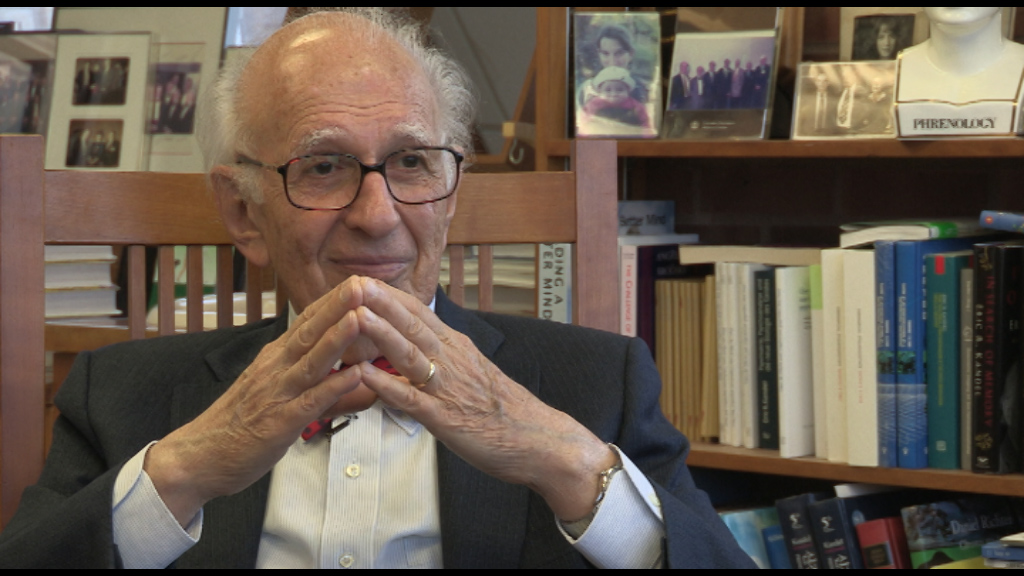NEXT STORY

How I came to study the brain
RELATED STORIES

NEXT STORY

How I came to study the brain
RELATED STORIES


|
Views | Duration | |
|---|---|---|---|
| 11. How I got into Harvard | 315 | 01:07 | |
| 12. Blossoming intellectually at Erasmus Hall | 151 | 00:55 | |
| 13. Gaining an education thanks to my parents' hard work | 157 | 01:24 | |
| 14. Enjoying academe | 138 | 03:08 | |
| 15. Meeting the Kris family | 138 | 02:25 | |
| 16. How I came to study the brain | 218 | 02:42 | |
| 17. Studying the direct cortical response | 149 | 02:55 | |
| 18. My inspiring wife | 185 | 03:12 | |
| 19. How Denise survived the war | 145 | 04:06 | |
| 20. Working with Stanley Crain | 97 | 03:19 |


In my junior year, I fell in love with a woman who was from Vienna, Anna Kris. And she made a major, major impact on my life. She introduced me to her parents, Marianne and Ernst Kris. And they were members of the Freud circle. Marianne Kris was Anna Freud’s closest friend. She had been in analysis with Sigmund Freud and Ernst Kris was an analyst. [He became an analyst] after he married Marianne and got interested in analysis, but before that he had been a major art historian. And he was the teacher of Gombrich. And we got to know each other, and I got very close to him, and he said, ‘You want to understand what happened in Austria and Germany, you’re not going to do it through intellectual history. You want to understand motivation, the human mind, how people can act brutally. The only one way to do it is to study the mind, that’s through psychoanalysis.’ So I began to read Freud, and listen some more to him, and I became convinced this is the way to go.
So on short notice, I only had sort of a gut course in the natural sciences, I think as a sophomore, never taken any science courses. I went to summer school between my junior and senior year, at 1588 Mass Avenue, in a phenomenal house. In that house I shared the house with Bob Spitzer who [later became] head of [DSM-III], a major revolution in American psychiatry; Bob Goldberger who became provost of Columbia University; Henry Nunberg who was the son of a very famous analyst. I’m leaving somebody… and Jimmy Schwartz became a very close collaborator and friend of mine. Fabulous people, I learned a great deal from them. And they were all taking summer courses, and I took chemistry, unbelievably boring. And in my senior year I took physics and biology, and then the following summer I took organic chemistry, but I was accepted in medical school on the basis of just one course I’d taken over the summer, because my other record was good. I was accepted to NYU medical school. So I went to medical school with no particular interest in science.
Eric Kandel (b. 1929) is an American neuropsychiatrist. He was a recipient of the 2000 Nobel Prize in Physiology or Medicine for his research on the physiological basis of memory storage in neurons. He shared the prize with Arvid Carlsson and Paul Greengard. Kandel, who had studied psychoanalysis, wanted to understand how memory works. His mentor, Harry Grundfest, said, 'If you want to understand the brain you're going to have to take a reductionist approach, one cell at a time.' Kandel then studied the neural system of the sea slug Aplysia californica, which has large nerve cells amenable to experimental manipulation and is a member of the simplest group of animals known to be capable of learning. Kandel is a professor of biochemistry and biophysics at the College of Physicians and Surgeons at Columbia University. He is also Senior Investigator in the Howard Hughes Medical Institute. He was the founding director of the Center for Neurobiology and Behavior, which is now the Department of Neuroscience at Columbia University. Kandel's popularized account chronicling his life and research, 'In Search of Memory: The Emergence of a New Science of Mind', was awarded the 2006 Los Angeles Times Book Award for Science and Technology.
Title: Meeting the Kris family
Listeners: Christopher Sykes
Christopher Sykes is an independent documentary producer who has made a number of films about science and scientists for BBC TV, Channel Four, and PBS.
Tags: Anna Kris, Marianne Kris, Ernst Kris, Anna Freud, Sigmund Freud, Robert Spitzer, Robert Goldberger, Henry Nunberg, James Schwartz
Duration: 2 minutes, 25 seconds
Date story recorded: June 2015
Date story went live: 04 May 2016